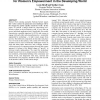CHI
2011
ACM
13 years 3 months ago
2011
ACM
We performed a study of Facebook users to examine how they coped with limitations of the Facebook privacy settings interface. Students graduating and joining the workforce create ...
CHI
2011
ACM
13 years 3 months ago
2011
ACM
Nonparametric data from multi-factor experiments arise often in human-computer interaction (HCI). Examples may include error counts, Likert responses, and preference tallies. But ...
CHI
2011
ACM
13 years 3 months ago
2011
ACM
We all spend time every day looking for information in our email, yet we know little about this refinding process. Some users expend considerable preparatory effort creating compl...
CHI
2011
ACM
13 years 3 months ago
2011
ACM
We investigate the breaking of ties between individuals in the online social network of Twitter, a hugely popular social media service. Building on sociology concepts such as stre...
CHI
2011
ACM
13 years 3 months ago
2011
ACM
The quantity of email people receive each day can be overwhelming. Previous research suggests that when handling email, individuals prioritize certain messages for attention over ...
CHI
2011
ACM
13 years 3 months ago
2011
ACM
With millions of teenagers on the Internet, millions of parents are trying to understand what their teens are doing and why. Understanding how technology use impacts teens‘ lear...
CHI
2011
ACM
13 years 3 months ago
2011
ACM
We present Interactive Generator (InGen), a self-powered wireless rotary input device capable of generating haptic or force feedback without the need for any external power source...
CHI
2011
ACM
13 years 3 months ago
2011
ACM
Pulitzer Prize-winning journalist Nicholas Kristof argues that “in this century the paramount moral challenge will be the struggle for gender equality around the world.” In th...
CHI
2011
ACM
13 years 3 months ago
2011
ACM
Modern smartphones contain sophisticated sensors to monitor three-dimensional movement of the device. These sensors permit devices to recognize motion gestures— deliberate movem...
CHI
2011
ACM
13 years 3 months ago
2011
ACM
While usability methods such as user studies and inspections can reveal a wide range of problems, they do so for only a subset of an application’s features and states. We presen...




